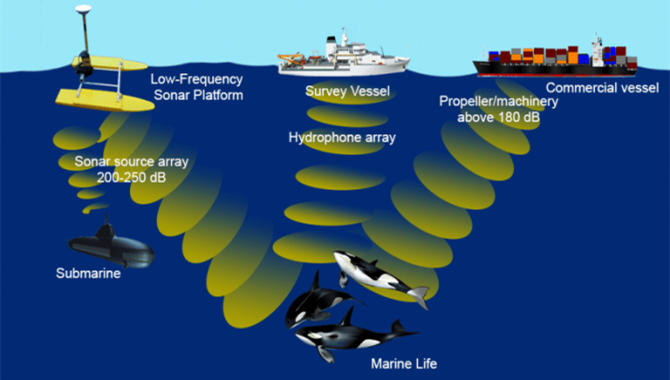
Just as much salvation has been brought to the world due to developments in marine industry in terms of better technology, there is no denying the fact that simultaneously the natural balance of things has had to pay a price. With ship transportation picking up pace, the environmental effects of it is now surfacing. Among them, effects of noise pollution especially on marine life are highly prominent.
Two main reasons that make environmental impact of noise in marine life especially grave are- firstly noise travels much more in water, covering greater distances than it would do on land while travelling though air, and secondly because the marine life is extremely sensitive to noise pollution. Due to their extreme reliance on underwater sounds for basic life functions like searching for food and mate and an absence of any mechanism to safeguard them against it, underwater noise pollution disrupts marine life in more serious ways.
Source of ocean noise pollution include everything from the ship noise to the low frequency sonar ‘sounds’ used extensively in submarine detection or even the seismic air gun noise from oil and gas exploration or even commercial shipping traffic and coastal jet ski traffic. Studies have showed that while these ‘sounds’ may have no impact on human, in marine life, they can be detrimental. Population of cetacean (whales and dolphins) has declined in areas prone to such noise pollution from ships.
The death of animals can occur merely hours after exposure to extreme underwater noise for example whales can die soon enough due to standings. Beaching themselves shortly after a tactical sonar exercise is a rather common environmental impact of noise pollution. Such beaching has been reported in regions like Greece, Madeira, Hawaii, Spain and the coastal US- areas where sonar exercises are common.
Mass stranding of giant squids in coastal areas of Spain between 2001 and 2003 showed how grave the implications of noise pollution in marine life can be. These beaching can occur merely hours after such an exercise. Dislocation or movement of marine animals to newer location is also one of the many ocean noise pollution effects. While this may seem like a survival mechanisms, studies conducted for a follow up on these animals isn’t that promising as most animals fail to acclimatize in the new environment, not to mention loss of diversity in many regions.
The effect of underwater noise pollution is more painful than anything else for the animals. Most animals are alarmed by the alien sounds. The deaths can occur due to hemorrhages, changed diving pattern, migration to newer places, and damage to internal organs and an overall panic response to the foreign sounds. There is also a disruption in normal communication between marine animals as a result of underwater noise pollution. This means animals prone to noise pollution are unable to call their mates, look for food or even make a cry for help under such circumstances.
Many marine animals like the fish (rockfish, herring, san eel, cod, blue whiting etc) show signs of extensive damage to their ears upon exposure to seismic air guns even up to several kilometers. Exposure to noise during embryonic stage increases sensitivity of fish to noise impact, increasing the mortality rates at time of birth and development of genetic anomalies. The migration to new areas not only affects the marine diversity balance but indirectly affects humans too. A decreased catch in many fish species like herring, cod and blue whiting especially in areas susceptible to noise pollution from ships has been noticed.
Sensitivity of various marine animals to ocean noise pollution is varying. While cetaceans like whales and dolphins may show a greater resistance, soft shelled species like mollusks, prawns, fish etc are much more sensitive. However, it is important to note that as many as 24 cetacean species have shown negative effects of noise pollution in ocean. In all about 55 marine species have been noted to have suffered due to exposure to sound of varying frequencies. These include sperm whale, grey whale, mink whale, pygmy sperm whale, killer whale, sea bass, pink snapper, goldfish, cod, haddock, bluefin tuna, squid, lobster, brown shrimp etc.
There is a reason why ocean is called as the ‘silent world’. In this world, where sounds of their own exist, there is no room or rather any need for foreign sounds to breach the harmony of their world. Studies are being conducted to understand effects of noise pollution on marine life in a much better way. But until a safe mechanism can be thought of which will ensure that marine animals do not continue to commit as much as mass suicide due to human errors, safety through prevention is out best shot at keeping the sanctity of this ‘silent world’ intact.
Source:Marine Insight
The opinions expressed herein are the author's and not necessarily those of The Xinde Marine News.
Please Contact Us at:







